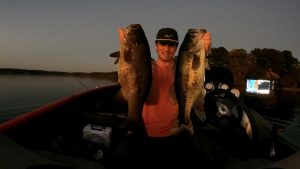Seasonal Warmth and Bass Behavior Shifts
October 22nd brought the end of a three-day warming trend across Massachusetts, where air temperatures reached between the upper 60s and low 70s—a refreshing change from the previous cold stretch. As the third day of this warm front approached, anglers anticipated a noticeable shift in bass behavior. With winds projected under 5 mph, conditions were set for a glass-calm outing, a rare chance late in the season to capitalize on a fleeting weather window.
(Note: On The Water is reader-supported. Purchases made through links on their site may result in affiliate commissions.)
The Approach to Fishing the Late-Season Window
The approach to maximizing the limited window of daylight involved a focused two-phase plan: hitting the lake for the last two hours of light and taking a quick break before meeting up with fellow angler Anthony “Cheech” DeiCicchi for an evening shift. Calm conditions favored subtle presentations, so only confidence baits were selected: the Beast Coast Lil’ Magnum jig and a Z-Man Finesse TRD ned rig—proven bottom baits that are effective in late fall.
Instead of constantly switching lures, staying focused on high-yield areas, like submerged points and high spots (humps) close to deep water, proved effective. The target depth ranged from 12 to 20 feet, although adjacent shallow spots weren’t overlooked.
The effort paid off quickly, with a quality largemouth caught on a main lake hump. When daylight is limited, hitting the lake’s prime spots quickly improves the odds of a good catch. A few additional bass were picked off on two separate points, and right before the sun dipped, a Massachusetts personal-best smallmouth—a 5.1-pounder—was successfully boated.

Fishing Success Late in the Day
Late-season fishing success often relies on hitting productive spots in rapid succession, especially when daylight is scarce. With only minutes of sunlight left, a final cast yielded the prized smallmouth before the lake settled into dusk. As the light faded, the plan shifted to meet DeiCicchi, targeting areas rich in baitfish activity. With nighttime stretching ahead, there was room to explore coves and flats, seeking a giant bass that might have moved up to feed as temperatures cooled.
The Nighttime Bite
Juvenile river herring in the area begin migrating from ponds to deeper waters in fall, a phenomenon that can trigger bursts of bass activity during warming periods. Targeting a cove with visible baitfish activity, a three-pound smallmouth hit a topwater walking bait almost immediately. Moving to a pocket where a few large fish had shown on a Garmin LiveScope during the day but resisted bites, DeiCicchi attempted to tempt a large bass with a Huddleston swimbait in a trout pattern but had no takers.
Switching to a perch-patterned Pat’s wakebait proved effective, attracting the attention of a large bass as it swam over. As the fish moved up from the bottom and struck the bait, DeiCicchi landed an impressive 4.7-pound smallmouth.
The Importance of Seasonal Weather Patterns
As days shorten, tracking late-season weather windows becomes even more critical. A short spell of warm, sunny days can temporarily improve fishing conditions, even during work weeks. Keeping a close eye on conditions and seizing these short opportunities can lead to excellent fishing experiences, even late in the season.
Image/Source: OnTheWater





